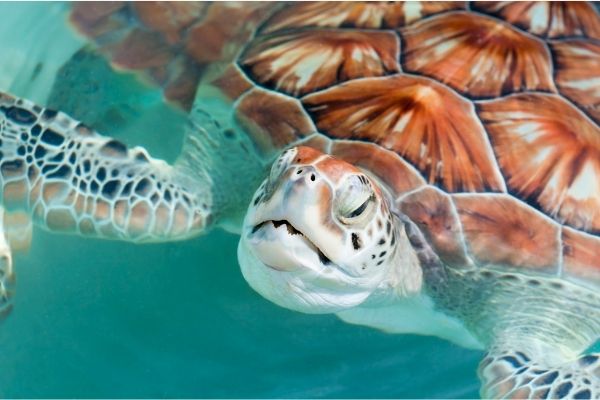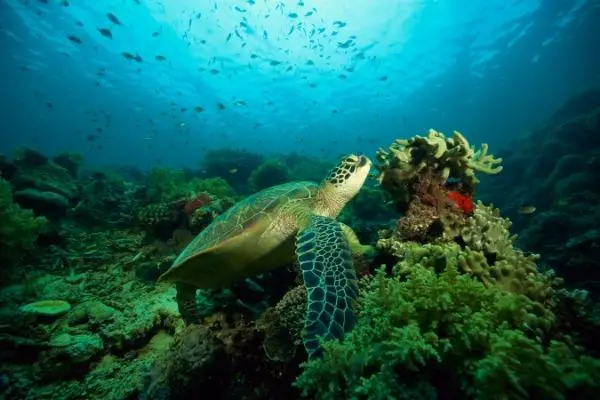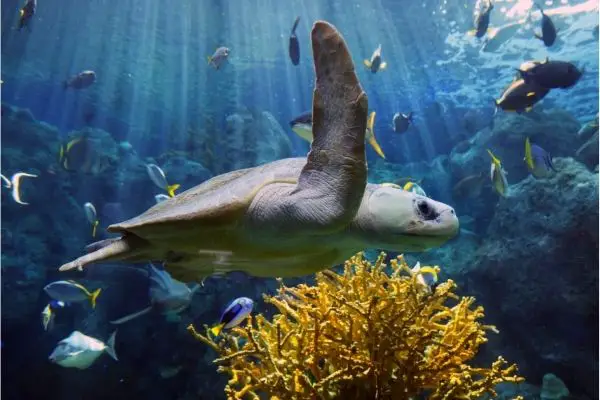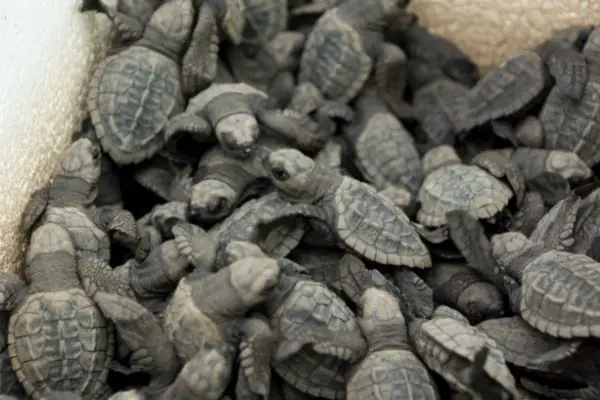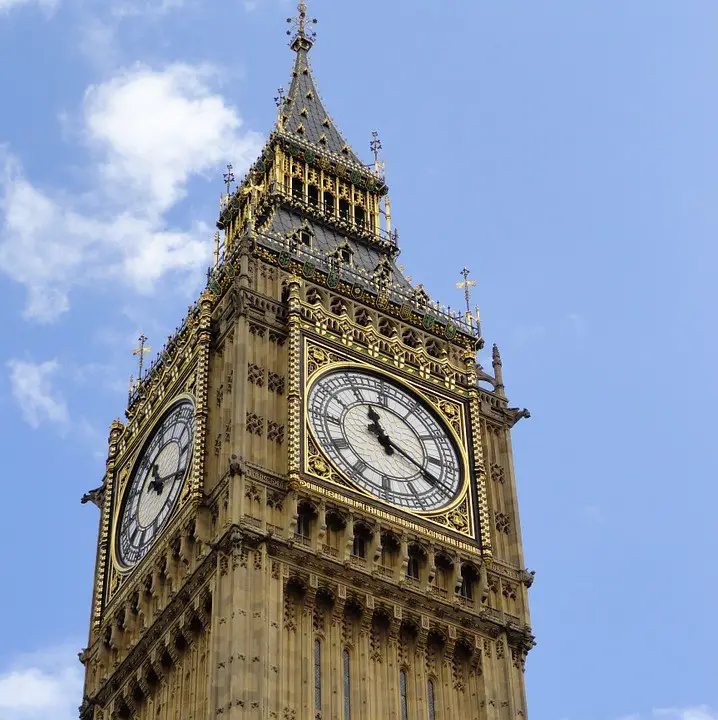Sea Turtles are among the few marine reptiles that are found throughout the world in tropical and subtropical seas. We have listed down complete Sea Turtles Facts For Kids that will help you in learning all about Sea Turtles. You are going to learn about its scientific name & classification, evolution, appearance, physical features, physical abilities, diet, habitat, lifespan, reproduction, babies, behavior, adaptations, food chain, ecological role, endangerment, population, predators, and many other interesting facts about Sea Turtles.
Sea Turtles Facts For Kids
What Is A Sea Turtle
- Sea turtles are air-breathing large-sized reptiles.
- They belong to the order Testudines and suborder Cryptodira.
- They are also known as marine turtles.
- There are seven living species of sea turtles.
- Sea turtles have large protective shells on their body.
- They are found throughout the world’s oceans except the polar (Arctic and Antarctic).
- Most of their species are omnivores and consume marine invertebrates, seaweeds, and seagrasses.
Scientific Name Of Sea Turtle
The following are the scientific names of the living sea turtle species:
- Chelonia mydas
- Caretta caretta
- Lepidochelys kempii
- Lepidochelys olivacea
- Eretmochelys imbricata
- Natator depressus
- Dermochelys coriacea
Scientific Classification Of Sea Turtle
The following is the taxonomy or scientific classification of sea turtles:
| Kingdom | Animalia |
| Phylum | Chordata |
| Subphylum | Vertebrata |
| Class | Reptilia |
| Order | Testudines |
| Sub-order | Cryptodira |
| Clade | Americhelydia |
| Clade | Panchelonioidea |
| Superfamily | Chelonioidea |
Sea Turtle Species
There are seven living species of sea turtles. The following is a brief description of each species:
Green sea turtle or green turtle or Pacific green turtle (Chelonia mydas)
This species is the only member of the genus Chelonia. It belongs to the family Cheloniidae. It is found all over the tropical and subtropical seas in the world. This species is Endangered on the IUCN Red List.
Loggerhead sea turtle (Caretta caretta)
Loggerhead sea turtle is a species of the genus Caretta. It also belongs to the family Cheloniidae. It is found throughout the world’s oceans, except the Arctic and Antarctic oceans. The IUCN Red List listed the species as Vulnerable.
Kemp’s ridley sea turtle or Atlantic ridley sea turtle (Lepidochelys kempii)
This species belongs to the genus Lepidochelys and the family Cheloniidae. Of all the species of sea turtles, it is the rarest species and is listed as Critically Endangered by the IUCN Red List.
Olive ridley sea turtle Or the Pacific ridley sea turtle (Lepidochelys olivacea)
This species also belongs to the genus Lepidochelys and the family Cheloniidae. Of all the sea turtle species, it is the most abundant and found in the warm and tropical waters of the Pacific, Indian, and Atlantic oceans.
Hawksbill sea turtle (Eretmochelys imbricata)
This species belongs to the family Cheloniidae. It is the only living species in the genus Eretmochelys. This species is distributed worldwide. It is Critically Endangered on the IUCN Red List.
Flatback sea turtle (Natator depressus)
This species also belongs to the family Cheloniidae. This species is native to the continental shelf of Australia. They have a flattened shell as compared to other sea turtles.
Leatherback sea turtle (Dermochelys coriacea)
This species is the only living member of the genus Dermochelys. It belongs to the family Dermochelyidae. This species does not have a bony shell like other sea turtles but instead has a covering of skin and oily flesh.
Sea Turtle Evolution
- The origin of sea turtles dates back to about 150 million years ago in the Late Jurassic.
- Around 110 million years ago, modern sea turtles formed single radiation and became distinct from other sea turtles. They started to develop the armor plating (like their ancestor Proganochelys), and to live a semi-aquatic life. Their body also started to become streamlined.
Importance Of Sea Turtle – Ecological Role Of Sea Turtles
- Sea turtles are keystone species of their environment and affect other animal species around them.
- They control the population of their prey, such as jellyfish, Echinoderms, and mollusks. They also eat sponges and help the reefs, which compete with sponges for space.
- Some sea turtle species also graze on seagrasses and maintain the health of seagrass beds. Healthy seagrass beds store carbon and benefit many aquatic animal species.
- Sea turtles lay eggs on the coast. Their eggs and hatchlings are an important food source for many animal species.
What Does A Sea Turtle Look Like
Appearance
- Sea turtles have a fusiform body with large streamlined shells.
- Their head and limbs are non-retractable and they can not pull it inside their shell.
- There is no sexual dimorphism in sea turtles and both male and female individuals have the same body size and appearance.
- They have flippers like limbs and elongated heads.
- The body of all species is covered with a large shell. The upper side of the shell is known as carapace while the lower side is known as plastron.
- The shell of all the species (except leatherback species) are made up of horny plates known as scutes. Leatherback turtles have flexible, leathery, and rubbery carapaces.
- Sea turtles are named on the basis of their distinctive features. For example, leatherback sea turtle is named for its leathery carapace, the hawksbill turtle is named for its beak-like pointed mouth, flatback turtle is for its smooth flat-domed shell, the green turtle is for the green fat beneath its carapace, loggerhead turtle for its large head, and olive ridley for its color of shell.
Color
The color of all the sea turtle species is described in the following bullet points:
-
Green sea turtle
Black in hatchlings, dark brown to olive in juveniles, plan brown or spotted with variegated rays in adults. The underneath is hued yellow.
-
Loggerhead sea turtle
Yellow-orange or reddish-brown carapace, pale-yellow undersides, brown neck and sides.
-
Kemp’s ridley sea turtle
Olive-grey carapace, off-white or pale yellow undersides.
-
Olive ridley sea turtle
Olive carapace with pale-yellow or off-white undersides.
-
Hawksbill sea turtle
Amber background with irregular patterns of black and mottled-brown streaks.
-
Flatback sea turtle
Olive green or grey-green mix and pale-yellow undersides.
-
Leatherback sea turtle
Black or dark grey with white spots and blotches. The undersides are of light color.
Physical Features
The physical features of all the sea turtle species are shown in the following table:
| S.No | Species Common Name | Weight | Length |
| 1 | Green sea turtle | 68 to 190 kg (150 to 419 lbs) | 0.7 to 1.1 meters (2.58 to 3.66 feet) |
| 2 | Loggerhead sea turtle | 80 to 200 kg (180 to 440 lbs) | 0.7 to 0.9 meter (2.3 to 3.0 feet) |
| 3 | Kemp’s ridley sea turtle | 36 to 45 kg (79 to 99 lbs) | 0.58 to 0.71 meters (1.9 to 2.3 feet) |
| 4 | Olive ridley sea turtle | 25 to 46 kg (55 to 101 lbs) | 0.6 meter (2 feet) |
| 5 | Hawksbill sea turtle | 80 kg (180 lbs) | 1 meter (3 feet) |
| 6 | Flatback sea turtle | 70 to 90 kg (155 to 200 lbs) | 0.7 to 0.9 meter (2.5 to 3.1 feet) |
| 7 | Leatherback sea turtle | 250 to 700 kg (550 to 1,540 lbs) | 1.83 to 2.2 meters (6.0 to 7.2 feet) |
Physical Abilities Of Sea Turtles
Speed
- Sea turtles are slow creatures and swim at the speed of 2.8 to 10 km/h (1.7 to 6.2 mph).
- The speed is slightly varied between species.
- The leatherback sea turtle is the fastest sea turtle species and swims as fast as 35 km/h (22 mph) for short bursts.
- They are very slow on the ground.
Jump
- Most sea turtle species jump between 3 to 4 inches.
- Their jump is very short and is not like that of humans or other animals.
Climb
- Sea turtles are adapted to aquatic life and leave the water only to lay eggs.
- They can not climb trees or other things.
Swim
- Sea turtles are well-adapted to an aquatic lifestyle and are excellent swimmers.
- They use their flipper-like limbs to pull water and move quickly.
What Do Sea Turtles Eat
Diet
-
In Wild
-
- Four species of sea turtles (olive ridley, Kemp’s ridley, loggerhead, and hawksbill) are omnivores in nature and consume a wide variety of plants and animals.
- Their diet is composed of seagrasses, seaweeds, decapods, mollusks, Echinoderms, cnidarians, sponges, worms, and fish.
- Some species consume specialized diets.
- Leatherback sea turtles consume only jellyfish. Their obligate feeding nature helps to control the population of jellyfish.
- Hawksbill sea turtles primarily consume sponges, which make 70 to 90% of their diet.
- The diet of green sea turtles varies with their age. Juveniles consume an omnivore diet but they become exclusively herbivorous as they mature. Their green color is due to their shift from omnivore to herbivore diet. They also have well-adapted serrated jaws, which they use to eat algae and seagrasses.
- Flatback sea turtles predominantly consume a carnivorous diet (shrimps, jellyfish, mollusks, soft corals, and other invertebrates) but also sometimes eat seagrasses and seaweeds.
-
In Captivity
-
- In captivity, sea turtles are fed with fish, meat, commercially prepared pelleted foods, and a variety of plants and vegetables.
List Of Food Items
The following are some of the major food items sea turtles eat:
- Seagrasses
- Seaweeds
- Algae
- Echinoderms
- Mollusks
- Decapods
- Sponges
- Fish
- Jellyfish
- Shrimps
- Worms
How Much Sea Turtles Eat Per Day
- The exact amount of food sea turtles consume per day is unknown.
- However, estimation shows that they eat about 73% of their body weight per day.
What Do Baby Sea Turtles Eat
- Baby sea turtles or hatchlings eat a variety of foods like zooplanktons, nekton, jellyfish, fish eggs, hydrazones, and sargassum seaweeds.
Where Do Sea Turtles Live – Sea Turtles Habitat
Natural Habitat
- Green sea turtles are commonly found in shallow tropical and subtropical waters and also in coastline beaches. They inhabit the regions with abundant seagrasses and algae.
- Loggerhead sea turtles inhabit the open ocean and shallow coastal waters. They inhabit waters with surface temperature from 13.3 to 28 ℃ (56 to 82 ℉). The nesting female prefer temperature from 27 to 28 ℃ (81 to 82 ℉). Their preferred habitat change throughout their lifecycle. Adults and juveniles are mostly found in coastal waters and prefer muddy or rocky substrates. Juveniles also prefer the sargassum habitat. Loggerhead sea turtles may be also found near coral reefs and go into brackish lagoons, river mouths, and salt marshes.
- Kemp’s ridley sea turtles are found in shallow coastal regions. They prefer to live in waters with muddy or sandy bottoms. Male individuals are found only offshore while the females come to the shores for nesting.
- Olive Ridley sea turtles mostly inhabit shallow waters and stay about 15 km offshore. They prefer to feed and take sunbath in shallow seas. They are also observed in the open ocean.
- Hawksbill sea turtles are found in hard-bottomed and reef habitats. They are also found in lagoons of oceanic islands, shoals, and continental shelves. Generally, they are found in shallow waters less than 60 feet in depth. Young individuals inhabit masses of floating sea plants, such as sargassum, because they can not dive in deep waters.
- Flatback sea turtles inhabit the tropical and subtropical waters with soft-bottomed sea beds. Females prefer to make their nesting site on sandy beaches of tropical and subtropical regions.
- Leatherback sea turtles inhabit the pelagic zone, but are also observed in the coastal waters. Females lay eggs in the sand of tropical beaches and it is the only time when they emerge from water onto land.
Biome
- Sea turtles are found in the coastal, brackish water, reef, and pelagic biomes.
Range
-
Green sea turtles:
-
- The habitat range of green sea turtles is throughout the world and covers the coastal regions of more than 140 countries.
- There are two major genetically distinct subpopulations of green sea turtles; one is found in the coastal waters of the Atlantic and the other in the eastern Pacific.
-
Loggerhead sea turtle:
-
- The habitat range of the loggerhead sea turtles covers about all the temperate and tropical oceans of the world.
- In the Atlantic Ocean, they are found from Newfoundland to Argentina, in the Pacific Ocean from Alaska to Chile and Australia to Japan, from southern Africa to Arabian Gulf and western Australia in the Indian Ocean, and in the Mediterranian Sea.
- During the winter season, they migrate to tropical and subtropical waters.
-
Kemp’s ridley sea turtle:
-
- This species is found from Nova Scotia and Newfoundland to Bermuda.
- Adult individuals are mainly found in the Gulf of Mexico.
- They usually follow two major routes when migrating; one heads southwards to the shores of Yucatan Peninsula at the Campeche Bank and the other extends northward to the Mississippi coastline.
-
Olive Ridley sea turtle:
-
- The habitat range of this species is very large and covers the tropical and subtropical regions of the Pacific, Indian, and Southern Atlantic oceans.
- In North America, they are found along the Gulf of California and in the Caribbean Sea.
- They usually remain within the latitudes of 40° North and 40° South.
-
Hawksbill sea turtle:
-
- The habitat range of the Hawksbill sea turtle is very wide.
- It covers the tropical regions of the Pacific, Atlantic, and Indian Oceans.
-
Flatback sea turtle:
-
- The habitat range of flatback sea turtle species is very restricted among all the sea turtle species.
- They are native to Australia and rarely travel towards the coastal waters of Papua New Guinea or the Tropic of Capricorn.
-
Leatherback sea turtle:
-
- The habitat range of leatherback sea turtles is globally cosmopolitan.
- Their habitat range covers all the tropical and subtropical oceans and extends to the Arctic circle.
- Their habitat range is the widest among all the sea turtle species.
Countries List
- Sea turtles inhabit more than 140 countries throughout the world.
Sea Turtle’s Lifespan
The lifespan of all the sea turtle species is shown in the following table:
| S.No | Species | Lifespan In The Wild | Lifespan In Captivity |
| 1 | Green sea turtle | 75 to 80 years | Unknown |
| 2 | Loggerhead sea turtle | 30 to 62 years | 33 years |
| 3 | Kemp’s ridley sea turtle | 30 to 50 years | Unknown |
| 4 | Olive ridley sea turtle | 50 to 60 years | About 50 to 60 years |
| 5 | Hawksbill sea turtle | 30 to 50 years | About 20+ years |
| 6 | Flatback sea turtle | 50 years (average), 100 years (maximum) | Unknown |
| 7 | Leatherback sea turtle | 45 years | 30 years |
Sea Turtle’s Life Cycle
- The life cycle of a sea turtle starts when it hatches the egg after the incubation of 50 to 60 days.
- After hatching, it makes its way to the sea and lives there.
- Sea turtles take years to reach sexual maturity. In some species, it takes decades.
- A mature sea turtle then starts mating and laying eggs.
- The average lifespan of sea turtles is unknown. They live for 30 to 70 or 80 years depending on the species.
Sea Turtle Reproduction
- Sea turtles reach sexual maturity after years and even decades. Leatherback sea turtles become sexually mature at the age of 7 to 13 years, both the ridley species at 11 to 16 years, hawksbill at 20 to 25 years, loggerhead at 25 to 35 years, and green sea turtles at the age of 26 to 40 years. Estimates vary greatly among species and even in different populations of the same species.
- In most species, courtship occurs several weeks before the nesting season.
- A female usually mates with two or more males. Mating occurs inside the water.
- The front flippers of males have enlarged claws which help them to grasp the shell of females during mating.
- Fertilization in sea turtles is internal.
- The nesting female drags herself onto the beach to find a suitable site and sand for the nest. She always does so at night time.
- To make a nest, she uses her hind flippers and digs a 16 to 20 inches (40 to 50 cm) deep hole.
- After digging, she starts laying eggs and fills the nest with a clutch of eggs.
- A clutch may have 50 to 350 eggs, depending on the species.
- After laying eggs, she recovers the nest with sand and smooths the surface. She then camouflages the nest with vegetation and makes it visually undetectable.
- To make the nest secure, she may also dig decoy nests to trick predators.
- The entire process of nesting takes about 30 to 60 minutes.
- The female then goes back to the sea and leaves the eggs untended.
- In a single season, a female may lay 1 to 8 clutches of eggs.
- In most species, the females nest individually. However, both the ridley species come ashore in masses or groups known as arribada (which means arrival). In Kemp’s ridley species, it happens in the daytime.
- There is a temperature-dependent sex determination (TSD) in sea turtles, which means the sex of the developing baby depends on the temperature it experienced. Females hatch from the eggs that experienced a warmer temperature, while males from the eggs that experienced a cooler temperature.
- The incubation period for eggs is 50 to 60 days.
- Hatching occurs at night in most species, except the Kemp’s ridley species in which it occurs at the day.
Sea Turtle Egg
- A sea turtle’s egg has a ping pong ball-like shape.
- It has a soft shell and a leathery or papery texture.
- A thick clear mucus surrounds the egg.
Sea Turtle Baby
- A baby sea turtle is called a hatchling.
- The hatchlings use a special egg tooth to break off the eggshell and hatch.
- At hatch, a hatchling has about two-inch size and one-half-pound weight.
- After hatching, a baby may struggle for 3 to 7 days to dig its way to the surface of the nest.
- It then waits for the night to emerge from the nest and avoid emerging in the daytime.
- A hatchling then starts traveling towards the sea. There are several theories about how a hatchling finds the sea:
-
- It may differentiate between the light intensities and go towards the high light intensity of the open horizon.
- It may use an internal magnetic compass to navigate away from the beach.
- Upon reaching the surf, a hatchling dives into a wave.
- When entering the water, a hatchling frantically swims for 24 to 48 hours.
Sea Turtle Male Vs Female
- Male sea turtles have a long tail that extends a foot long from their shell, while the tail of females does not extend their shell.
- Male sea turtles also have enlarged claws on their front flippers.
Sea Turtle Behavior
- Sea turtles are not social and gather only to mate. When a hatchling reaches water, it stays alone until it becomes mature and starts mating. In some species, individuals sometimes congregate offshore. Females of some species (Kemp’s and olive ridley species) travel to the nesting ground in masses.
- Not much is known about the individual behavior of sea turtles. Some species bask in the sun while floating on the water surface and asleep while some bask on the beaches. Some species rest in corals or rock ledges and some often return every night to the same site for resting.
Sea Turtle Adaptations
The following are some of the major structural and physiological adaptations of sea turtles:
Physical Or Structural Adaptations
-
Streamlined Body
-
- Sea turtles have a well-adapted streamlined body plane, which reduces drag force and friction in water and allows them to swim easily and swiftly.
-
Large Bony Shell
-
- Except for leatherback sea turtles, all the sea turtle species have a hard bony shell over their body.
- Their shells act as a shield and protect their body from injuries.
-
Flipper Like Forelimbs
-
- The forelimbs of sea turtles are modified into flippers, which they use to swim.
- It is an important adaptation because sea turtles spend their whole lives in the sea.
Physiological Adaptations
-
Special Lacrimal Glands
-
- Sea turtles have well-adapted large lacrimal glands that play a vital role in osmoregulation.
- Having these glands is an important physiological adaptation to their marine habitat because their internal environment is hypotonic to the outer environment of the ocean. Which means the osmotic pressure of their body fluid is lower than the water of the ocean.
- To maintain hypotonicity, they must remove excess salt from their body.
- As their kidneys can not produce highly concentrated urine to excrete excess salt so they depend on their lacrimal glands.
- These glands produce tears that have a higher salt concentration than the ocean water.
- Leatherback turtles have exceptionally large lacrimal glands because they eat jellyfish and other gelatinous planktons whose fluid have a higher salt concentration similar to seawater. Due to their diet, they face an increased osmotic pressure than other species and so their lacrimal glands evolved to be larger.
-
Thermoregulation
-
- Sea turtles are poikilotherms (cold blooded) and can not regulate their internal body temperature without the help of behavioral means, such as burrowing or basking.
- Their large body size, dark skin color, and thick fat layer attract and trap heat and help them to stay warm.
-
Large Lungs
-
- Sea turtles are air-breathing creatures and regularly come to the water surface for breathing.
- They have large lungs which help them to hold breath for long intervals underwater.
- Their diving duration is 5 to 40 minutes when foraging, while they can stay for 4 to 7 hours underwater when sleeping.
- Their large lungs also allow a rapid exchange of oxygen and help them to avoid trapping gasses during deep diving.
-
Magnetoreception
-
- Magnetoreception is a sense that enables an organism to detect magnetic fields of the Earth and perceive altitude, direction, or location.
- Migratory sea turtles have a magnetic compass sense as well as a coordinate magnetic map through which they navigate within strong gyre currents in the open sea.
Sea Turtles Food Chain
- Sea turtles are omnivores and consume marine vegetations as well as small marine animals.
- Green sea turtles are the primary consumers as they eat only vegetations.
- Leatherback sea turtles eat only jellyfish and are tertiary consumers in the food chain.
- Other species are also tertiary consumers in the food chain as they eat vegetations (producers) and small marine animals (primary and secondary consumers).
Population
- According to recent estimations, the total population of all the sea turtle species is about 6.5 million.
- The number of every species varies greatly.
- The estimated population of the hawksbill species is from 83,000 to 57,000.
- While the estimated population of the flatback and Kemp’s ridley species is 69,000 and 25,000 individuals, respectively.
- The population trend of all species is declining.
Sea Turtles Endangerment
Reasons
The major reasons for the endangerment of sea turtles are:
- Poaching and excessive hunting for their meat, shells, skin, and eggs.
- Habitat destruction with light pollution from developed beaches and oil spills.
- Climate change causes an increase in temperature, which affects the nesting sites and gender distribution of sea turtles.
- Bycatch is another threat for the sea turtles. Imprecise fishing methods (especially long-lining) leads to accidents with sea turtles and their death.
- Predators like foxes, raccoons, and seabirds excessively hunt the sea turtles’ eggs and hatchlings. It has been estimated that only one egg from a nest of 100 eggs survives to adulthood.
- Marine debris, such as plastics, are sometimes mistaken for jellyfish that cause serious injuries to sea turtles. They are also often entangled in abandoned fishing nets.
Conservation Status
The conservation status of all the sea turtle species is shown in the following table:
| S.No | Species | Conservation Status On The IUCN Red List |
| 1 | Green sea turtle | Endangered |
| 2 | Loggerhead sea turtle | Vulnerable |
| 3 | Kemp’s ridley sea turtle | Critically Endangered |
| 4 | Olive ridley sea turtle | Vulnerable |
| 5 | Hawksbill sea turtle | Critically Endangered |
| 6 | Flatback sea turtle | Data deficient |
| 7 | Leatherback sea turtle | Vulnerable |
Diseases And Parasites
- Fibropapillomatosis is a disease that affects sea turtles.
- This disease causes tumors on the surface of biological tissues.
Sea Turtles Predators – What Eats Sea Turtles
- Due to their large size, adult sea turtles have very few natural predators, such as sharks, crocodiles, and jaguars.
- Hatchlings are very vulnerable and are often fall prey to raccoons, coyotes, wild boars, crabs, and sea birds.
- People hunt sea turtles for meat, shell, and skin. Their eggs are also eaten.
Sea Turtles Fun Facts
- Sea turtles spend their entire lives in water except for the breeding females that come ashore to make nest and lay eggs.
- The largest populations of sea turtles are found in the Australian Great Barrier Reef and the Caribbean sea.
- Sea turtles excrete excess salt from their body through the lacrimal glands (tear glands) found in their eyes. When sea turtles come ashore, they look crying due to the secretion of salts and fluid from their eyes.
- The diving duration of sea turtles greatly depends on the activity. Foraging sea turtles dive for 5 to 40 minutes while sleeping sea turtles can stay underwater for 4 to 7 hours.
- Studies have shown that the sextual maturity of sea turtles is often related to the size of their carapace.
- In some cases, female sea turtles return to the same beach where she hatched to lay eggs.
- Heat exposure to the eggs during the incubation period is responsible for the sex of hatchlings. The eggs that got warmer temperature hatch females while those that experienced cooler temperature hatch males.
- Sea turtles have a sharp vision underwater. However, they can not see well in the air.
- The shell of sea turtles is part of its skeleton, which is made up of 50 bones including its spine and rib cage.
- Sea turtles possess an internal compass through which they detect the magnetic field of the Earth. Adults use it to navigate while the hatchlings use it to orient to the magnetic field of the Earth during their frenzy swim.
FAQs:
Are Sea Turtles Dangerous To Humans?
- Sea turtles are not dangerous to humans.
- However, they will bite if they feel threatened or provoked.
How Many Sea Turtles Are Left?
- According to a recent estimate, around 6.5 million sea turtles are left in the wild.
Why Do Humans Kill Sea Turtles?
- Humans kill sea turtles for their meat, shell, and skin.
Do Plastic Straws Really Kill Turtles?
- Researchers of the Australian government agency, the Commonwealth Scientific and Industrial Research Organization (CSIRO), discovered that when a turtle ingest one item of plastic, it has 22% chances to die of it.
- Another estimation reveals that around 1,000 sea turtles die each year from ingesting and digesting plastics.
What Is The Biggest Turtle In The World?
- Leatherback sea turtle is the biggest turtle of all the turtles in the world.
What Do Turtles Do For Us?
- Turtles do not do anything for us directly.
- However, they play a vital role to maintain the health of the environment.
- A healthy environment is necessary for us to stay healthy and safe on this planet.
What Kind Of Animal Is A Turtle?
- A turtle is a reptile whose body is encased in a bony shell.
What Do Turtles Do For The Environment?
Turtles do a lot for the environment, for example:
- They eat sponges and help to save coral reefs
- They control the population of jellyfish
- They graze on seagrasses and keep the sea bed healthy
What Does A Sea Turtle Egg Look Like?
- The sea turtle egg looks like a ping pong ball in size and shape.
- It usually has a spherical shape and has a soft shell.
What Time Of Day Do Sea Turtles Hatch?
- Sea turtles may hatch any time of the day.
- However, they wait for the night to emerge from the nest to be less exposed to daytime predators.
What Kills Turtles?
- Sharks, crocodiles, jaguars, and foxes kill adult turtles.
- While raccoons, crabs, coyotes, ants, and sea birds kill the hatchlings.
What Is The Smallest Sea Turtle?
- Kemp’s ridley sea turtle is the smallest of all the sea turtle species.
What Time Of Year Do Turtles Hatch?
- Sea turtles usually hatch in the summer.
- However, they will hatch throughout the year.
What Ocean Do Sea Turtles Live In?
- Sea turtles live in the Pacific, Atlantic, and Indian Oceans.

